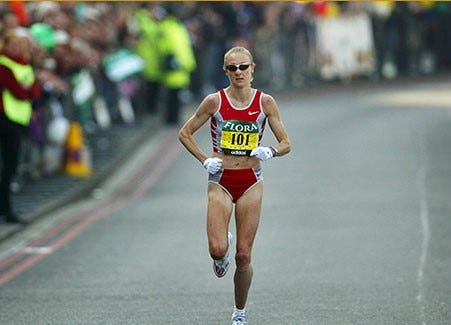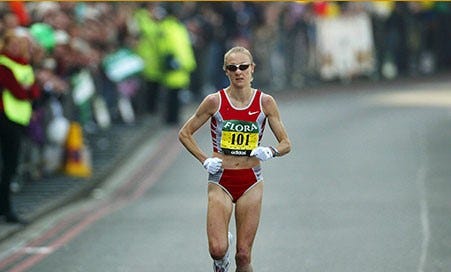The Art of Losing
Dear reader,
Welcome to Weekly Carb-Loading! Your Sunday morning dose of running and fitness inspiration.
We believe every run has a story, and we’re bringing these stories to you, with runner profiles, race histories, home workouts and a whole lot more!
This week, we have a special feature - a guest post by one of our readers! Have a seat, take off those slippers, relax and enjoy! Later in the newsletter, we continue our ‘Runner Workout’ series, with ‘Shoulder Strengthening’, and a Fun Feature to cap off the week.
Before we dive in, if Gmail sent this newsletter to your ‘Promotions’ tab, you can simply drop us an email in reply, to prevent this from happening. Just a ‘Hi’ should do. You may also scroll to the very end of this post for more solutions. Thanks!
The Art of Losing
“I enjoyed the work that went into making yourself the best you can be but I hated what the scoreboard doesn’t say. It just tells you if you won or lost.”
- Andre Agassi, in an interview with The Guardian, 2017
Few sporting careers are as enigmatic as that of the understated tennis legend, Andre Agassi. His extraordinary, fairy-tale journey is simply riveting. Among other things, his story shines a light on an act that somehow, we human beings are conditioned to avoid since birth - to lose.
The outcome of every game is a win for one team and a loss for the other. At least, objectively. But perhaps failure or losing, is not so much of a devil that it is made out to be.
Failure is just an interpretation of a life situation. Painful, yet temporary. In fact, the impermanence of the pain of a loss is no different than the impermanence of the excitement of a win!
Today, we spend some time introspecting on the art of losing, on how some athletes, even in the face of imminent defeat, possess this rare yet magical ability to dig deeper into their resource pool and play a game that compels the audience to look beyond the scoreboard.
Perhaps, it is this very characteristic that distinguishes a good athlete from a great one. It is the temperament of a player, when the stakes are high and the odds are stacked against her, that decide whether her game will be a cherished memory or a mere number on the scorecard.
—
The Magic Moments In-between
A match between Serena Williams and Maria Sharapova is thrilling and exciting for a reason. We all know that one will go on to lift the trophy and the other will have to be content being a runner-up for now. But it is the moments between the first serve and the final outcome that constitute the play.
It is in these moments that rare feats are achieved, magical shots are taken, errors of judgement are made, exasperated yells are bawled, and lighter moments are shared in rivalries.
Packed in these moments are glimpses of an athlete’s mindset. A mindset that allows no room for mistake but creates a vast spaciousness for intuitive plays to unfold. It is these serendipitous moments that make a match worthwhile for the players even when loss looms large on the horizon.
—
When Limit Approaches Infinity
For years, Britain’s celebrated runner Paula Radcliffe struggled to find her sweet spot on the track. Leading from the front in her major races at the Olympics and the world championships, she would lose out in the final moments of the sprint finish. This way of losing seemed to become her pattern for a while and still, it was not to be her destiny.
If she had hung up her boots being defeated by the outcome of the track races, we wouldn’t have had the chance to witness her awe-inspiring World Record on the marathon distance, which stood untouched for over 16 years! (Kenya’s Brigid Kosgei created a new world record last year at the Chicago Marathon.)
Instead, the athlete in Paula gathered her losses, went back to the drawing board, reviewed her weaknesses and techniques, and crossed over this threshold to transition into one of the best athletes the world has seen.
She never did win an Olympic medal, but on the morning of 13th April 2003 on the streets of London, she erased the pre-conceived boundaries of distance running.

Like Radcliffe, great players do not train to play a finite game where winning and losing are the only determinants of success. They play an infinite game where they are present in every movement, engaged in every shot, devoted to every swing, with a complete surrender to the moment they are in.
This infinite mindset arises from a profound, unconditional love for the game and its process, one which transcends the man-made limits of victory and loss. Unlike the result, this intense love is not fleeting, and that is what makes them formidable even in their defeat.
You may just need to google the name Akhwari to realise the power of this rare yet enduring love that characterizes extraordinary athletes.
In the 1968 Olympics held at Mexico, John Stephen Akhwari from Tanzania was not likely to win the marathon. In fact, he was barely making it through the cramps due to the high altitude. About half-way into the race, Akhwari was caught among a few athletes who were jockeying for position, and fell. He was badly hurt on the knees and shoulders. Upon receiving medical attention, he went back to continue his race, finishing last with a gap of more than an hour to the winner.
Akhwari completed the race not for glory, not for cheers, not for any reward. But because, as he put it, “My country did not send me 5,000 miles to start the race; they sent me 5,000 miles to finish the race.” Now what could be closer to Zen?
—
Choosing Freedom Over Fear
In his enduring piece of work, “Man’s Search for Meaning”, Viktor Frankl pays tribute to hope in times of loss, suffering and despair.
He writes, “… everything can be taken from a [hu]man but one thing: the last of the human freedoms – to choose one’s attitude in any given set of circumstances, to choose one’s own way.”
In a subtle and somewhat elusive manner, the rigors of training shape an athlete’s mindset to choose freedom over fear. Operating from a place of freedom, great athletes leave no space for the fearful ego to thrive. It simply vanishes into thin air.
What remains are the precipitates of quality. The quality of equanimity, of compassion, of sisterhood, of honest hard work, of finishing what is started, of being present in every moment, and in the end when the whistle blows, walking to the other side and shaking the hand of your opponent, regardless of the result.
When amateur runners take up the uphill task of training for a marathon somewhere unknown to their self, they cultivate this very formidable attitude. Those eighteen weeks of relentless effort, early morning alarms, foregoing the taproom drama, mindful eating, the highs of touching the six-minute-mile (even if only for two precious seconds) and the lows of painfully slow recovery runs, grows an intimate awareness of the body and mind in every athlete.
—
Subtle Yet Significant
In these training weeks a runner unlearns many of her preconceived biases, and opens herself to a spaciousness, not just in running but in all aspects of life. This spaciousness allows her to resist the urge to quit, when the going gets tough.
The practice of focusing on effortless posture builds an unwavering focus on every task in her daily life. Running an extra mile on tired legs stretches her boundaries a little bit more, to allow for that extra legroom which makes the journey a tad bit easier.
In fact, the training is an act in itself filled with drama, action, romance, envy, tragedy, and comedy. The runner has been through it all and so, the marathon event becomes simply, a closing ceremony.
In an unassuming fashion, completing the process of training instills a sense of lasting joy and conditions a runner’s mind to treat the uncertain outcome of the event with lightness and equanimity. Isn’t that what most therapists want you to do?
—
That is the beauty of sports. You cannot work them. You can only play them. And playing is always a process, never the result. That is why every true player is there to play as much as possible until the whistle blows.
Our guest post this week was written by Ankita Singh.
Ankita is a social researcher by profession, and enjoys distance running, reading, and hiking in the mountains.
Runner Workouts - Shoulder Strength
This section brings you simple, easy-to-do home workouts which help you become a stronger runner, increase your stamina and reduce chances of injury.
Last week, we introduced a few basic Back Strengthening exercises. This week, we concentrate on Shoulders.
Benefits
For a runner to maintain posture and run efficiently over longer distances, and to remain injury free through the marathon season, upper body strength and arm swing technique is of utmost importance.
Powerful shoulders and a controlled arm swing help a runner maintain stability on each step, and carry momentum from one step to the next most efficiently. Conserving energy allows us to run longer distances.
Over longer runs, strong shoulders and arms also aid us in carrying nutrition and hydration (in our hand or a backpack), while keeping upper body fatigue at bay and not slouching.
Strong muscles around the shoulders are beneficial for non-runners as well as runners. They are used extensively in cross training or weight training workouts, while strengthening other parts of our body.
—
This week, we introduce a few basic shoulder strengthening exercises into our routine in the video above, which can all be done right at home, with a help of a couple of 1 litre water bottles (or lightweight dumbbells)
As with any workout, please start slow without weights and concentrate only on the movement, to get your form right. You may also try the workout in front of a mirror to achieve the best form. Please pause the video as many times as you require.
General Instructions: Please wear sturdy shoes and loose, comfortable clothing. Hydrate well during the workout. If you experience unusual pain in any part of your body, stop immediately and seek medical advise from your doctor.
New to workouts, and wondering how to get started?
For absolute beginners, a few weeks of regular physical activity like walking, running or cycling would be helpful, before moving on to body strengthening exercises.
Over the last two months, we covered a range of Beginner Workouts just for you, these can be found in our Archive!
Did You Know
Last week, we featured the Boston Marathon and Katherine Switzer’s iconic moment captured in print. In 2017, she ran it again. At the age of 70!
Fun Feature of the Week
This hilarious video is doing the rounds on social media this week! Which type of runner are you? :D
Quote of the Week
Do you agree?
That’s a wrap from us this week!
If you like our content, please do endorse us to your friends! You can share this post via Whatsapp, and subscribe to receive a fresh dose of carbs in your inbox every Sunday morning!
This post can also be read on our website.
Follow us on Twitter for small servings of carbs throughout the week!
Stay healthy, stay fit, and stay safe! <3
Gmail sometimes sends us to your ‘Promotions’ tab. Here are a few ways to prevent this from happening
Drop a reply to this email <weeklycarbloading@substack.com>. A simple ‘Hi’ should be good enough
Open any email from Weekly Carb-Loading in your Web-browser
At the top of the email, under ‘More’ (three vertical dots) select ‘Filter Messages Like These’ -> ‘Create A Filter’
Select the second-from-last box ‘Categorize As..’ -> ‘Primary’, as well as the last box ‘Apply the filter to all matching conversations’
Click ‘Create’, and you’re done! All future emails will automatically be redirected to your Primary inbox
You may also choose to
Mark emails from ‘Weekly Carb-Loading Newsletter’ as ‘Important’
Add <weeklycarbloading@substack.com> to your Contact List





